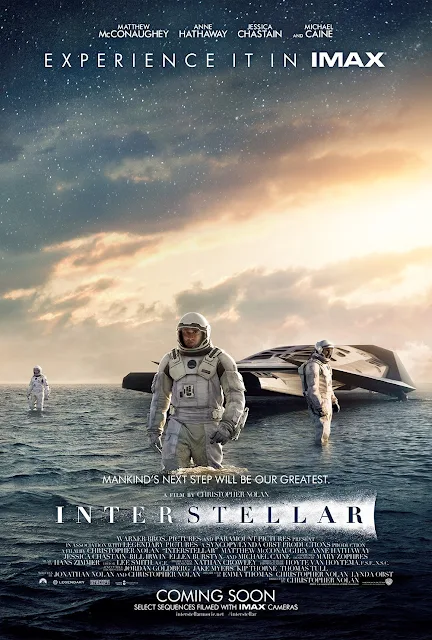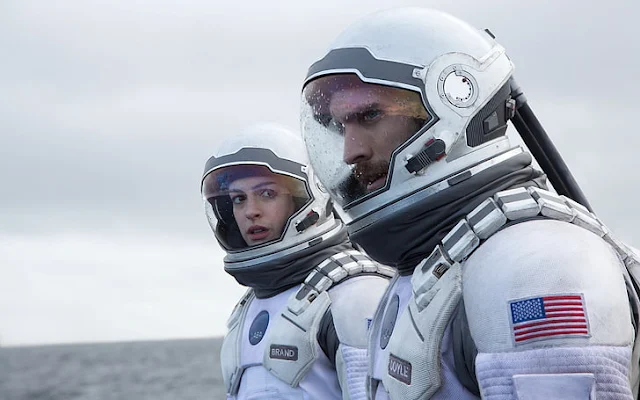Set in a future teetering on the edge of environmental collapse, Interstellar weaves a narrative that traverses the farthest reaches of space and the most intimate corners of the human soul. The film’s intricate tapestry, built on the foundations of rigorous scientific theory, is elevated by Hans Zimmer’s monumental score—a sonic experience so indelible it threatens to overshadow the film itself. But at its core, this isn’t just a tale of wormholes and relativity; it’s a meditation on humanity’s resilience, our drive to explore the unknown, and the intangible force of love that binds us across time and space.
More than a space epic, Interstellar unfolds as a deeply human story. With a cast led by a masterful Matthew McConaughey, joined by Anne Hathaway and Jessica Chastain (The Martian), the film probes the inner lives of its characters, peeling back layers of ambition, fear, and sacrifice. Nolan crafts a world that’s both vast and personal, asking profound questions about our place in the universe and the lengths we’ll go to secure a future for those we love. It’s not just a film—it’s a call to wonder.
Nolan is a long way from Batman Begins here!
Whether you're a seasoned film analyst, a space enthusiast, or someone intrigued by the interplay of emotion and science, this discussion promises a comprehensive thematic exploration of a film that is bound to be discussed and revered for generations to come.
Love Transcending Time and Space
"Interstellar" masterfully intertwines the threads of love, sacrifice, and the bonds that unite us, even across the vast expanse of time and space. Through the heartfelt connection between Cooper and Murph, as well as the contrasting dynamics of romantic love, the film explores the enduring power of love to transcend the boundaries of time, distance, and the cosmos.Cooper and Murph: A Bond Beyond Space and Time
At the heart of "Interstellar" lies the profound and unbreakable bond between Cooper and his daughter Murph. Their relationship serves as an emotional linchpin, emphasizing that love, in its purest form, can traverse the immense chasms of time and space. Cooper's decision to leave Earth and embark on the perilous mission to save humanity exacts a heavy toll – the separation from his family, particularly Murph, with whom he shares an extraordinary connection.
Scene Deep Dive: One of the most emotionally charged moments in the film is when Cooper reviews years of video messages sent by his children. The passage of decades on Earth, while only a few hours have elapsed for him due to relativistic effects, is a heart-wrenching revelation. The anguish etched on Cooper's face as he watches his children grow, evolve, and face the struggles of a world on the brink of extinction is palpable.
Romantic Love and the Influence of Emotion
Beyond the father-daughter dynamic, "Interstellar" also explores the idea of romantic love and its impact on decision-making. Dr. Amelia Brand represents this facet of the film's theme. Her belief in love as a guiding force, influencing not just personal emotions but also scientific decisions, stands in stark contrast to the fear-driven, self-preservationist motives of Dr. Mann (Matt Damon, lost in space... again).Scene Deep Dive: Dr. Mann's betrayal, as he manipulates data to ensure his survival, underscores the darker side of human nature when faced with the prospect of individual survival.
Love as a Unifying Theme
In "Interstellar," love is more than an emotional undercurrent; it's a unifying theme that threads through the narrative. Whether it's the love between a father and daughter, the love that fuels our search for new homes among the stars, or the love that influences our moral compass, the film suggests that love is the timeless force that binds us together, no matter the cosmic distances that separate us.In conclusion, "Interstellar" beautifully and profoundly explores the theme of love transcending time and space. Through Cooper and Murph's poignant bond and the contrasting dynamics of romantic love, the film invites viewers to contemplate the enduring power of love, even in the face of the vast unknowns of the universe. It serves as a reminder that love is the cosmic constant that unites humanity, offering solace, guidance, and hope across the boundless expanse of time and space.
The Moral Quandary of Dr. Mann
Dr. Mann's actions on his desolate planet serve as a haunting illustration of the theme of survival versus sacrifice. Mann, driven by desperation and fear, falsifies data to create the illusion of a habitable environment, deceiving both his fellow astronauts and those back on Earth. In doing so, he jeopardizes the entire mission, endangering the survival of humanity.
Mann's decision to prioritize his own survival over the greater good is a chilling reminder of the darker side of human nature. As he sabotages the mission and ruthlessly pursues his own interests, the film raises unsettling questions about the lengths to which individuals might go when faced with the abyss of isolation and desperation. Mann's actions serve as a cautionary tale, highlighting the moral fragility of the human psyche under extreme circumstances.
Ethical Crossroads
Throughout the film, the characters confront ethical crossroads where they must weigh their personal desires and survival instincts against the collective well-being of humanity. Cooper's decision to leave his family behind to embark on the space mission is one such example. While his departure is driven by a noble goal, it forces him to grapple with the emotional cost of his actions.
Sacrifice as a Redemptive Theme
As the narrative unfolds, sacrifice emerges as a redemptive theme in "Interstellar." Characters like Cooper and Dr. Mann (Matt Damon, Elysisum), who initially prioritize individual survival, ultimately find redemption through selfless acts. Cooper's journey through the tesseract, where he seeks to communicate crucial information to Murph, is an act of profound sacrifice driven by his love for his daughter and his commitment to saving humanity.
Collective Responsibility
"Interstellar" ultimately underscores the idea that in the face of existential threats, collective responsibility must prevail over individual survival instincts. The astronauts' mission is not just about personal heroism but about the collective efforts of humanity to secure its future. In this context, the theme of survival versus sacrifice serves as a moral crucible, challenging characters and viewers alike to consider the greater good.
Humanity's Place in the Universe
The universe, as depicted in the film, is both awe-inspiring and humbling—a vast, indifferent expanse where Earth appears as a mere pale blue dot. This cosmic perspective challenges our anthropocentric worldview, forcing us to grapple with the sobering reality of our insignificance within the grand cosmic scale.
Yet, Interstellar refuses to surrender humanity to insignificance. Amid the cold mechanics of relativity and the inscrutable mysteries of quantum mechanics, it elevates human emotions—love, hope, sacrifice, and curiosity—as the true constants of existence.
Cooper’s decision to leave his family, propelled by his love for his children and a desperate hope to save humanity, underscores the film’s central thesis: it is our emotional depth, not our technological feats, that imbues us with purpose. This is mirrored in Dr. Amelia Brand’s impassioned belief in love as a tangible force, unmeasurable yet deeply influential, proving that even in the face of cosmic indifference, humanity’s emotional core remains a defining, universal truth.
The Search for Meaning: Humanity’s Cosmic Reckoning
At its core, Interstellar is less about the mechanics of space travel and more about the existential questions that have haunted humanity for eons:Why are we here?
What defines our purpose?
What, in the infinite sprawl of the universe, makes us matter?
As its characters traverse black holes and alien worlds, they are simultaneously navigating an inward journey—an odyssey to uncover meaning amid the chaos of existence.
Hope as Humanity’s North Star
Nolan’s masterpiece pulses with an undercurrent of hope, defying the desolation of its narrative backdrop. Interstellar is not just about survival; it’s a hymn to resilience, a celebration of the human spirit’s refusal to surrender to despair.
Earth may be crumbling under the weight of blight and famine, but the film plants its flag firmly in the idea that humanity’s greatest strength is its ability to rise, adapt, and dare to dream beyond its confines.
A World on the Brink
The Earth in Interstellar is a stark portrait of ecological collapse, a planet teetering on the edge of irrelevance. Dust storms choke the air, crops fail, and society’s vision narrows to mere subsistence. Yet even in this bleak landscape, Nolan paints a portrait of quiet rebellion against despair.
From the stubborn ingenuity of farmers trying to coax life from dying soil to scientists daring to believe in salvation among the stars, the film pulses with the belief that humanity, even when cornered, will fight to survive—and thrive.
The Tesseract: Science Meets Spirit
The film’s climax catapults viewers into the fifth-dimensional construct of the tesseract, where theoretical physics intersects with the most profound human emotions. Time, here, is no longer linear but a physical dimension - a labyrinth of moments that Cooper navigates with both awe and desperation. This lattice of memories is more than a scientific marvel; it’s a metaphor for humanity’s interconnectedness, the choices we make, and the bonds that tether us across space and time.
In this surreal space, Cooper’s connection with his daughter Murph becomes the film’s emotional zenith. Using Morse code, he transmits vital information via the ticking of her watch, transforming the act of saving humanity into an intimate, deeply personal gesture. It’s a moment where the cold calculations of quantum mechanics give way to the warmth of love’s persistence, proving that even across dimensions, our need to connect remains unbreakable.
Humanity’s Defining Trait: Resilienc
If Interstellar is a monument to anything, it is to resilience. Whether facing the relentless waves of an alien planet, the solitude of deep space, or the heartbreak of leaving loved ones behind, its characters embody the human capacity to endure. Every setback is met with grit; every loss fuels a deeper determination. Nolan reminds us that even as time stretches and dimensions fold, it is this resilience—fueled by hope, love, and an unshakable belief in possibility—that will define our place in the cosmos.













